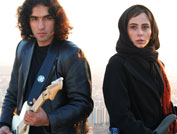Art21 Devotes Entire Program To South African Multimedia Artist
By Brandon Kosters
Whether he’s cantering like a horse through his studio and filming it, or having performers walk inside of gigantic paper noses which conceal everything but the performers’ legs, William Kentridge is fascinating.
Tonight, PBS premieres “William Kentridge: Anything is Possible,” the first Art21 film dedicated to one artist exclusively. In addition to be an extremely well constructed film in it’s own right, it offers keen insight into what informed Kentridge’s development as a visual artist, and what it looks like when he’s inside his studio.
The South African artist’s body of work encompasses theater, drawing, sculpture, video, and animation.
“I started off drawing, the way all children draw,” Kentridge says in the film. “All my years at university I was kind of drawing while waiting to see what I would become, and then went from drawing into theater school, ‘cause I was acting at the same time, and that was a complete disaster.” He went on to work in film and television.
It was during his time as a production designer that Kentridge had an epiphany of sorts, and recognized the importance of his personal artistic practice. “I was lying awake at four in the morning in a panic about [whether] I had the right period matchbox for the shooting the next day … I knew this wasn’t what I should be spending my life doing.”
Kentridge says his is largely about the “seriousness of play” and that experimentation and aimless exploration is what has yielded his proudest accomplishments. “It’s always kind of been inbetween what I thought I was doing that the real work has happened.”
We get to see Kentridge preparing for his production of The Nose, his adaptation of the Shostakovich opera of the same name, which was itself an adaptation of Nikolai Gogol’s story The Nose. Kentridge says that he drew inspiration, not just from the opera, but also directly from Gogol’s story, as well as from constructivist art and writing, and other movements which flourished in Russia in the early 1900s.
The show was staged at the Metropolitan Opera in New York in the spring.
We see samples of Kentridge’s charcoal animations, and he speaks about his exploration of drawing as a means generating images sequentially rather than generating a static image. Using a dense paper, Kentridge pushes and erases charcoal and photographs it, so that photographs of the drawings at various stages essentially become cells of animations.
Themes of multiplicity, and a sort of theatricality seem to permeate his entire body of work. This is part of the whole point: Finding places where multiple practices and methods converge, examining how the disparate fragments of his work feed each other, and honoring the fragments as pieces unto themselves.
We see him perform on stage, interacting with projections of videos he has created. We see him interacting with the singers and dancers who are performing in The Nose. He speaks about the degree to which growing up with anti-apartheid lawyer parents, and really, the political climate of South Africa perhaps more generally during apartheid, informed his practice.
And what’s more … we get to see him play soccer with his kid.
All this, and so much more, within an hour.
The show premieres October 21, at 10 p.m. EST on PBS.






